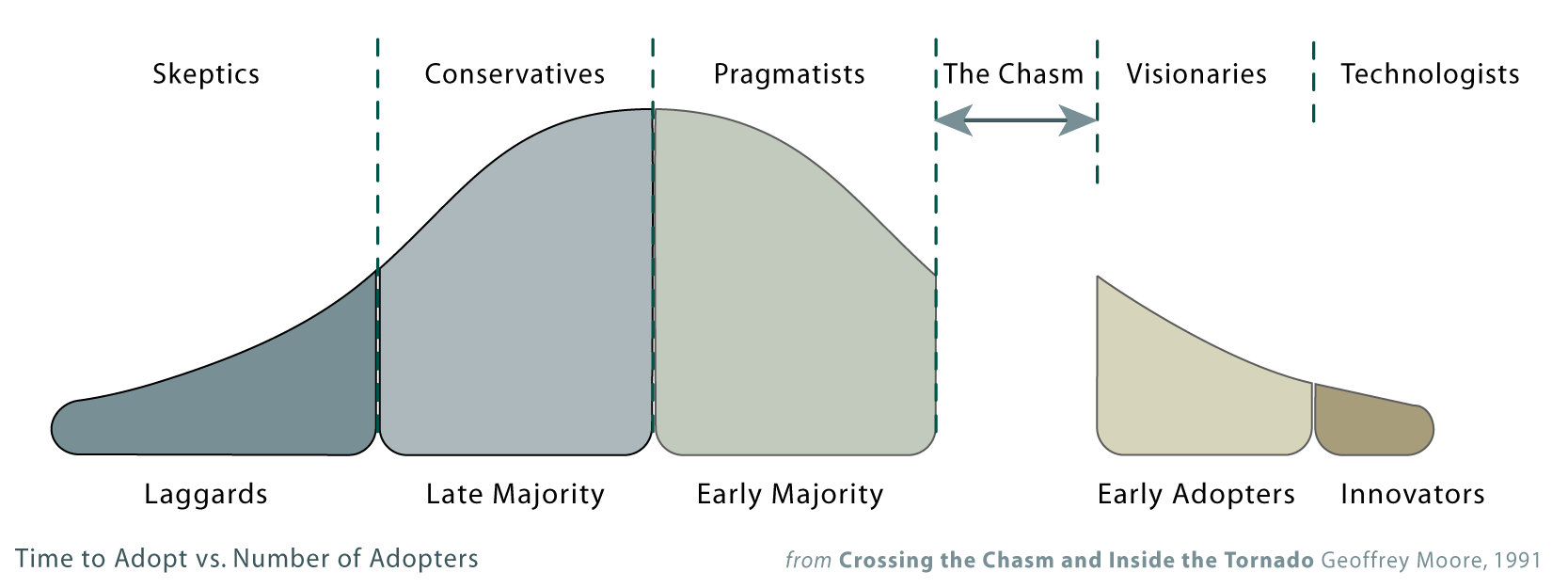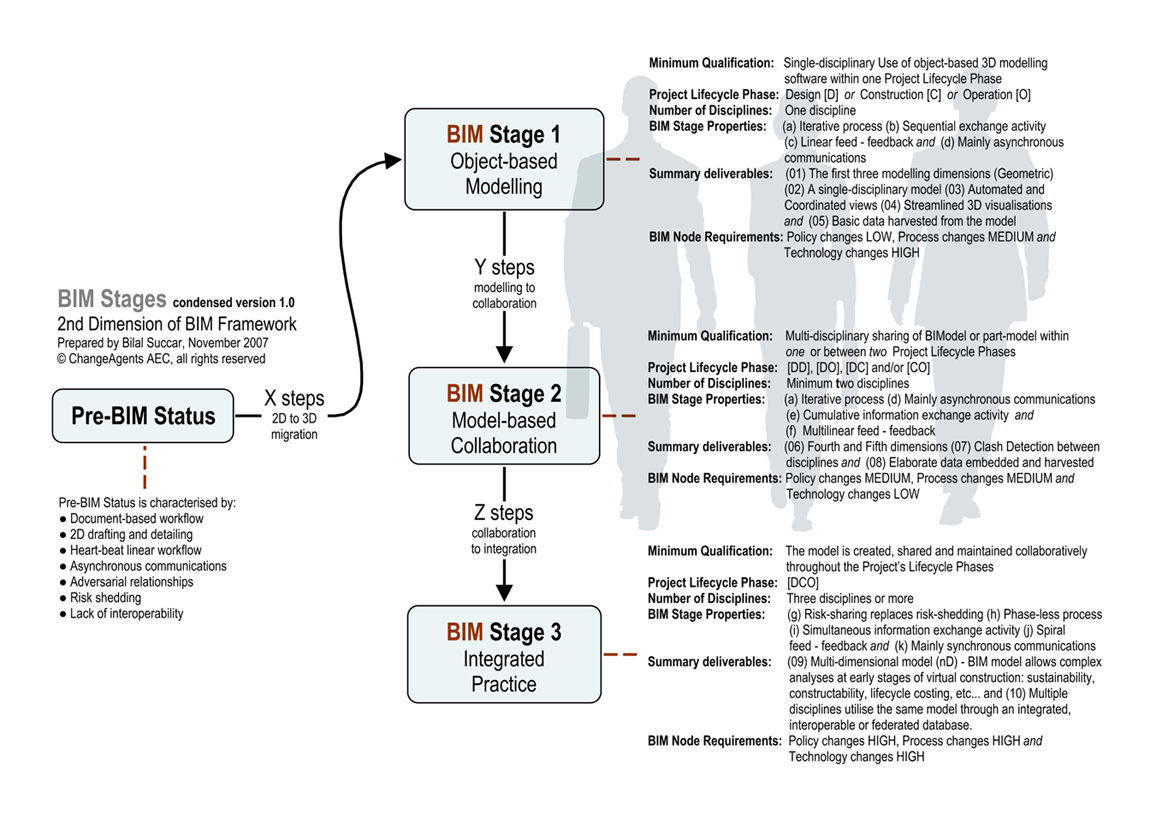Published on February 18, 2008 | Last Updated on September 13, 2025
Many industry discussions affectionately expand on BIM’s far-reaching deliverables: seamless collaboration, construction sequencing, shareable databases and fully integrated project delivery. While all these possibilities are foreseen today and are becoming more readily accessible as we speak (type), it is important to understand the deployment road ahead. Such an understanding will help us focus on the task at hand, better allocate available resources and prepare for the BIM-flavoured future.
This episode is available in other languages. For a list of all translated episodes, please refer to https://bimexcellence.org/thinkspace/translations/. The original English version continues below:
The previous episode has described the 1st dimension of the BIM Framework – ‘horizontal axis’ representing AEC players and their deliverables. It is now time to introduce the 2nd dimension – ‘vertical axis’ of BIM adoption. This episode intends to identify deployment milestones or ‘stages’ that AEC players pass through on their way to fully integrated practices. There are three stages/milestones:
- BIM Stage 1: Object-based modelling
- BIM Stage 2: Model-based collaboration
- BIM Stage 3: Network-based integration
Note that each of these stages is further subdivided into sequential steps. What separates ‘stages’ from ‘steps’ is that BIM Stages are transformational or radical1 changes while BIM Steps are incremental2 ones within them. In this post, we’ll focus our attention on identifying the transformational stages within BIM Nodes. We’ll do that after briefly describing the Pre-BIM status which insistently prevails within the AEC industry.
The Pre-BIM Status
At the Policy front, the Pre-BIM status is characterised by adversarial relationships as contractual arrangements encourage risk shedding and over-the-wall interactions. Moving to the Process front, there are huge dependencies on 2D documentation to describe 3D reality with all the problems this entails. Communication between different Players is less than adequate and project teams dismantle as projects reach a conclusion. Technology investment is low and data exchanges suffer from severe lack of interoperability3 between software applications…this surely cannot continue!
2D to 3D migration….BIM Stage 1
After being wholly dependent on hand sketches, CAD and 3D visualisations, an increasing number of companies decide to cross the innovation chasm and invest in the object-based BIM applications (Figure 8.1).

Figure 8.1: Crossing the Chasm by Geoffrey Moore
They quickly start to generate coordinated 2D documents and 3D visualisations from the BIM model but the parameter-rich model itself is not shared with other disciplines. Three-dimensional views and light-weight models (that may include object metadata but not active parameters – DWF, NWD, 3D PDF, KML files and the like) become the new phrases within a rejuvenated communication language. Through their adoption, these companies undergo ‘mild’ process change as they start generating a plethora of 3D views, quantities, specifications, what-if scenarios and other deliverables from the semantically-rich model. Since the BIM model is still single-disciplinary and the deliverables are mostly CAD-like documents, existing contractual relationships and liability issues persist….but not for long!
From modelling to collaboration…BIM Stage 2
Two disciplines, each ‘owning’ a semantically-rich model, decide to collaborate. They exchange and share models/databases which may not include geometry (think of Gantt charts, assets and environmental databases as examples of shareable databases). The two companies may jointly co-author a single database (example using ‘worksets’ in Autodesk® Revit®), link two different proprietary formats (example linking Digital Project® to a Primavera® database) or exchange non-proprietary files (example IFC, CIS2 or SDNF files). This ‘interopation’ allows them to perform 4D time-studies, interdisciplinary clash detection and generate an impressive array of analysis-driven deliverables. It is here where ‘traditional’ contractual relationships, risk models and ‘tried and tested processes’ start to show signs of significant strain and – with the absence of clear policy guidelines – nascent imaginative solutions.
From collaboration to integration…BIM Stage 3
This fulfillment of this stage is the compilation of all construction-efficiency dreams and BIM philosophies. At this stage, project lifecycle phases dissolve substantially and players interact in real-time to generate real benefits from increasingly virtual workflows. At this Stage, existing and fast improving technologies play enabling roles and one set of technologies play a pivotal role: the increasingly available Model Server, replication or other model-federating solutions. These specialised network-based technologies store, share and control multidisciplinary input/output from participating stakeholders. It is here where current contractual policies and project processes lose their sync with technological possibilities. Of course and over time, processes evolve and policies get developed to enable the full potential of semantically-rich models and externally referenced databases…it may be a long road ahead of us.

Figure 8.2: BIM Stages, a condensed view
The interesting thing about all these Stages is that necessary technology infrastructure currently exists or is being developed. Whether we’re discussing software, hardware or networks, all are emerging and maturing quite rapidly. Processes (albeit experimental) are starting to follow as innovative companies increasingly ally together and push the frontier. However, the biggest absentee is still the many Policy players (refer to classification in Episode 7) who are slow to react and generate the necessary guidelines, regulations, liability protection and educational programs necessary for systematic progress.
In summary
While Stage 1 only needs a BIM application and a champion and Stage 2 needs two players and the will to collaborate, Stage 3 needs much more than that. The Integrated Practice will need a systematic understanding followed by systematic consolidation of all relevant Technologies, Processes and Policies…It may be a long deployment road ahead of us but it’s surely a scenic drive!
Next Episode: understanding BIM Lenses
Update (July 20, 2015): A video is now available explaining BIM Stages on the BIM Framework’s YouTube channel:
References:
- Henderson, R. M. & Clark, K. B. (1990) Architectural Innovation: The Reconfiguration of Existing Product Technologies and the Failure of Established Firms. Administrative Science Quarterly, 35, 9.
- Taylor, J. & Levitt, R. E. (2005) Inter-organizational Knowledge Flow and Innovation Diffusion in Project-based Industries. 38th International Conference on System Sciences. Hawaii, USA.
- NIST (2004) Cost Analysis of Inadequate Interoperability in the U.S. Capital Facilities Industry. IN Gallaher, M. P. O. C., A. C.; Dettbarn, J. L., Jr.; Gilday, L. T. (Ed.), National Institute of Standards and Technology.
Cite as: BIMe Initiative (2025), 'Episode 8: Understanding BIM Stages', https://bimexcellence.org/thinkspace/the-bim-episode/. First published 18 February 2008. Viewed 31 December 2025

good and informative read. I, haowever, could not interpret the quoted word “interopation”,is it a typo or am I missing on something?
A typo no doubt! It should be ‘interoperability’.
Good catch, thank you Motasem 🙂